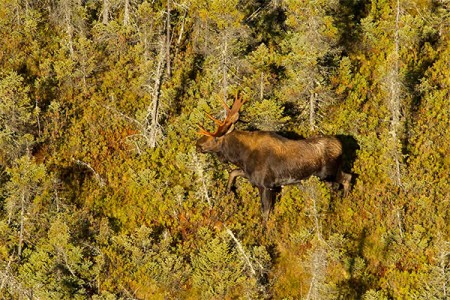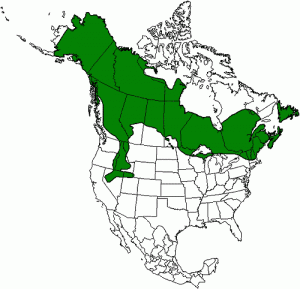Miserable times for moose?
Bats are struggling to survive white-nose syndrome. Bees are battling several problems, known and unknown. Monarch butterfly numbers have plummeted this year. These creatures are small in size, but important in the larger scheme of life.
Now come reports that moose, the biggest land mammal in these parts, are also in serious trouble.

A bull moose in Massawepie Mire (image taken from the air). Archive NCPR Photo of the Day 10/4/13: Larry Master.
According to a recent New York Times article:
What exactly has changed remains a mystery. Several factors are clearly at work. But a common thread in most hypotheses is climate change.
Winters have grown substantially shorter across much of the moose’s range. In New Hampshire, a longer fall with less snow has greatly increased the number of winter ticks, a devastating parasite. “You can get 100,000 ticks on a moose,” said Kristine Rines, a biologist with the state’s Fish and Game Department.
In Minnesota, the leading culprits are brain worms and liver flukes. Both spend part of their life cycles in snails, which thrive in moist environments.
So, death by tick, brain worm, liver fluke, or plain old starvation. Sounds nasty.
According to a similar report from Christian Science Monitor:
In New Hampshire, the moose population has dropped from some 7,000 moose to around just 4,600 animals. In Montana, numbers have fallen about 40 percent since 1995, and in Wyoming there are just 919 animals left – a quarter of the state’s target moose population. In Minnesota, the population in its northeast has been halved since about 2010, and moose have disappeared almost entirely from its northwest. Only Maine has seen an increase in its moose population, with some 75,000 animals living within its borders.
Moose aren’t found everywhere, but they do have a wide distribution across the north of this continent.

Distribution of moose in North America (source: Wild Animals of Manitoba)
In the wake of those U.S. news reports this CBC article summarizes the animal’s population and general health across Canada:
While the moose population is stable in Yukon, some parts of Canada have seen declines. According to B.C.’s Ministry of the Environment, moose populations have dropped by 50 per cent since 2005 in the Prince George region.
Other regions in B.C. have seen declines of almost 70 per cent in the same time.
On the whole, moose populations in Ontario and Quebec appear to be stable and even increasing in parts, but scientists are keeping an eye on the situation in the U.S. to see what lessons can be learned.
Here’s a little more on moose health in Ontario from the Toronto Star.
Brant Allison, senior northwest regional biologist with Ontario’s Ministry of Natural Resources, says that moose “are important to the biodiversity of the province.”
Allison said he is seeing declines in Canadian jurisdictions near Minnesota, including Manitoba and the northwestern and northeastern parts of Ontario.
“We are definitely concerned,” he said, adding that biologists in Ontario have been in touch with their counterparts in Minnesota and Manitoba to see what the current research reveals.
“We are watching. They’re still trying to figure it out,” he said.
Stay tuned, I guess.
In Box readers, for those of you who do encounter moose at home or on your travels, what have you been observing, if anything, in terms of animal health?
Tags: canada, climate change, ecology, environment, moose, moose decline, science








We all have our problems. I guess it comes with being mortal.
“What exactly has changed remains a mystery.”
A typical human contention about the rate at which humans are despoiling/ravaging spaceship Earth and the effect we are having upon all of her fauna and flora. As the article points out the numbers of parasites and the lengths of their active seasons has grown longer as the supposed nonevent of global warming, conveniently renamed climate change so as to mitigate the reality of it’s adverse impact, in which even the latest softball report from the IPCC contends there is a 95% likelihood it is brought to us by us.
I grew up primarily in the North Country from the early 40s through the early 60s and on and off thereafter such that during my 71+ years I have lived 40+- years in the North Country. From 1950 to 1956 I lived a stones throw up river from the Ranger School in Wanakena where I lived to roam the woods year around and what would amaze most of today’s parents I roamed miles from home usually alone with my faithful four legged friend Whiskers. Subsequent to my father being injured while working at Benson Mines we moved onto the flat of the St. Lawrence River Valley where I continued to roam the woods. In 1964 “my friends and neighbors” concluded that they wanted me to help kill Vietnamese and I was drafted, but joined the USAF, and ended up stationed in central Louisiana (England AFB). It was there that for the first time in my life (1965) I was exposed to TICKS, never having seen one while wandering the woods of northern NY for more than 15 years. I returned to NY (Champlain Valley) in 1978 through 1987 lived on a farm in Peru and still I observed no ticks. Moved to MD (lots of ticks there) came back in 2002 (still here) started noticing ticks on the dogs occasionally but as I was moving my belongings piecemeal myself traveling forth and back between NY and MD I assumed that they were picking up ticks when we were in MD so I started using a more potent flea and tick repellent/killer. Trips to MD became less and less frequent still an occasional tick on the dogs even in the Winter when I was not traveling to MD.
Anyone recall the Lyme’s disease numbers in St Lawrence Country this past Spring and Summer? I personally know one person who had it and know of 2-3 others and I live a near hermit existence. Let us consider that up through 1987 I never saw ticks on the critters on my farm in Peru when I left to work in MD. When I returned in 2002 the critters on my farm in De Kalb start showing up with ticks culminating this Spring/Summer with hundreds of folks in St Lawrence County being infected with Lyme’s disease. Therefore in about 25 years the North Country went from no (or so few one seldom noticed them) ticks to enough ticks to cause hundreds of cases of Lyme’s disease this year.
Although my anecdote concerning ticks may not be scientifically rigorous I believe that it is but one of multitudes of such, the disappearing moose for instance, that humans are glossing over because to do anything meaningful about them would require a paradigm change which would inconvenience the upper and upper middle classes far more than they are willing to be inconvenienced. It does amaze me the lip service that is expended talking about building a future for the upcoming generations whilst consuming spaceship Earth’s resources for convenience and with such avarice that the future generations are guaranteed to have nothing.
P. tenuis (brainworm) is a parasite that has multiple phases. Its eggs are passed out in cervid (deer, moose) feces, are picked up by snails. Their early life is spent in those snails, where ultimately, their impact is to modify snail behavior through brain infection so the snails climb up to tips of shrubs and grasses where they are eaten by deer and moose. They mature in those animals. The impact on deer is negligible, whereas they are fatal for moose. Early logging practices produced more edge in the ‘Dacks, which allowed increases in both moose and deer herds, which promoted P. tenuis, which, along with subsistence hunting, killed off the moose. It wasn’t until the return of so much old-growth forests along with resulting reduction in deer herds reduced P. tenuis enough for moose to come back; prior efforts to restore moose failed – with records suggesting brainworm was the problem (even though the cause of the disease wasn’t explained until a 1964 research report by Canadian biologist Roy Anderson).
I’m sure the biologists are tracking deer populations & P. tenuis as a component of the problem. Ticks are also shifting their habitat (parts of the ‘Dacks I’ve spent time in had nearly no ticks until recent years). Still, some other shifts out west are increases in white-tail range, with reductions in mule deer. Some changes in practices such as watering hole management has impacted wildlife significantly. New Hampshire is expecting increases in deer populations. Further, they are manageing for increases in the middle of the state, with reductions in the south, and in Coos county in the north. If I were looking for interactions between species, I’d be looking at these trends with monitoring for P. tenuis. NH also has warnings for Lyme and ticks.
Ken, Ticks and Lyme is spreading because over time something brought in like Lyme spreads. My son had Lyme this summer. There have always been plenty of mice and deer to spread a tick borne disease in the north country. I don’t think it has anything to do with the climate. But it might? As far as the moose. The tick problem in NH is very serious. What it is a mystery. I have lived in much warmer climates where I saw many more moose than I see around here. So I tend not to think it is a temperature thing. But maybe.
“the disappearing moose for instance, that humans are glossing over because to do anything meaningful about them would require a paradigm change which would inconvenience the upper and upper middle classes far more than they are willing to be inconvenienced.” What in the world are you talking about. Did you see that beautiful one here in NYS in the photo. When I was a kid we had zip. Now we might be approaching 1000. No one is glossing over anything either. It sounds like they are working on it where their is a problem. And reporting on it, and we are blogging on it… Where is the gloss?
“I don’t think it has anything to do with the climate. But it might?”
The climate / tick /infection connection has been well studied for quite some time now…
“it’s the seasonal cycle of feeding for each stage of the tick’s life that determines the severity of infection in a given region. The researchers found that this cycle is heavily influenced by climate.”
Not a biologist by any means. It would seem that like other parasites/ticks when we lose our very cold winters as we have; there would be more of these ticks and parasites. Much like the parasites hurting our trees that do no longer die in the winter.
Dave, true, the cycle is influenced by climate. But has it been influenced by climate in this case? Like I said it might. Glad they are working on it. Here is what they also said:
“We are watching. They’re still trying to figure it out,” he said.
I have seen more moose in Colorado and Wyoming (Rocky Mountain National Park and Teton National Park respectively) than I have seen anywhere else in the US. I saw 5 large bull moose together one summer in Colorado. This map is not accurate.
Also, I hope that the change in solar cycle will bring us back some colder winters and get rid of those nasty ticks. Maybe we will see the start later this week. My hope is that we will see an article here next fall titled:
“Miserable time for ticks”!!!
The map should show the range farther east into the Teton’s in Wyoming and farther south into Colorado.
Regardless they are an awesome animal. I wonder why they are doing so much better in Ontario and Quebec?
Isn’t everything better in Canada?